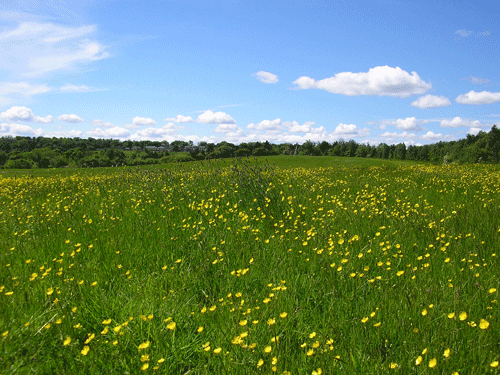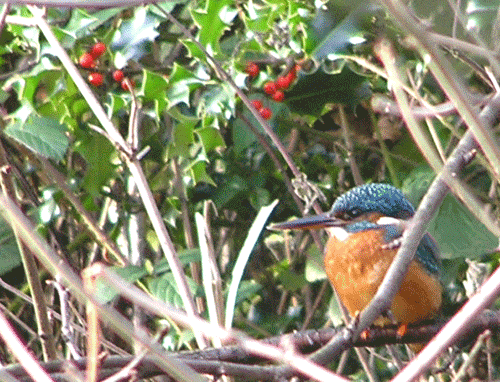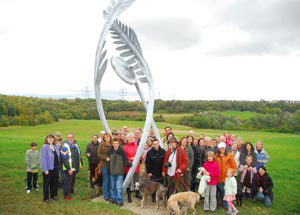Oakwell Hall Country Park
Formed from a mix of old woodland, farmland and a reclaimed colliery, over 110 acres of country park surrounds the hall and gardens.
Explore the park
The country park has continually won the Green Flag Award for excellence in green space management and is an important site for recreation, education and wildlife conservation.
Country Park landscape
Learn about the landscape, sculptures and woods surrounding Oakwell Hall.
Oakwell has over 110 acres of beautiful countryside for visitors to walk, play, picnic and breathe in - and all free of charge. The park is relatively new, but bears the impact of centuries of change.
In the 17th Century Batt family days, the estate had over 370 acres of farmland and the woods. Much woodland was lost over time, but has been restored and there is now more than in the 1700s.
Dramatic changes came in the 20th Century. In 1900 the Leeds New Line railway cut a swathe through the landscape. It was abandoned in the 1960s and reverted to woodland.
The Park is now managed for wildlife and public benefit. It has won many Awards for excellence in green space management and offers courses, workshops, events and volunteering opportunities. It has a network of footpaths; some are accessible to wheelchair users.

The Nature Trail helps you to explore the delightful landscape, trees, flowers and wildlife of the Country Park, offering a healthy stroll through peaceful, scenic beauty.
The Nature Trail follows a figure of eight route and is just less than two miles long. It is possible to walk either of the two loops in about 45 minutes, or to do the complete circuit in around an hour and a half. Follow the distinctive yellow oakleaf waymarkers and numbered posts. Please follow the Countryside Code at all times.

Find out more about the route and the wildlife you will encounter
Dogs must be kept on their leads at all times and there are dog waste bins provided.
The park has many recently wooded areas and areas of much older woodland. The last major felling - Asker Wood - was in the 1940s. It has been re planted and the bluebells, which once grew in abundance, clung on and are flourishing. In the 1930s Well Spring Wood was felled and allowed to regrow to form today's Nova Wood. Many of the older oak trees have multiple stems giving the wood a unique character.
You can find out more about the woods from our Oakwell nature trail leaflet, information panels along the trail.

Oakwell was once the site of a busy colliery, employing over 360 men in the 1960s. Gomersal Colliery, or 'Nutter Lane Pit', closed in 1973.
From the 14th Century scrape pits dug into hillsides were mined in the area. In the 18th and 19th Centuries coal was needed to power new textile mills, brickworks and ironworks. Transport networks improved and local pits developed. By the early 20th Century only deeper seams were still workable. In 1911 shafts were sunk and Gomersal Colliery opened in 1916.
In 1974 winding gear and buildings were demolished. In 1976 reclamation began; shafts were capped, sludge lagoons removed and grasses planted on levelled slag heaps. Today the site is planted with wildflowers and woodland; a haven for wildlife. A sculpture celebrates the mine and those that worked there.
In 1901 the London and North Western Railway opened a new rail line from Leeds to Huddersfield. Its official name was the Heaton Lodge and Wortley Line but it became known as the Leeds New Line.
It cut a swathe through the landscape around Oakwell Hall, cutting in half Well Spring Wood (known as Nova Wood by the 1950s). A map from 1907 shows a deep cutting to the east and an embankment to the west.
Passengers could now travel from Birstall, Cleckheaton and other local towns to the rest of the country with ease.
In the early 1960s the line was closed and the track was lifted. Today the line has been re-colonised by nature. The western side is used as a footpath and rideway.
Fiddlehead and Fernblades is an imposing metal sculpture standing over six metres tall.
In 2007 it replaced the sculpture Oak Log Fall by Andrew Darke, which had been installed in the late 1980s to celebrate the creation of the park - made of oak it was showing its age.
With assistance from the Awards for All lottery fund sculptor Adrian Moakes was appointed to create a brand new landmark sculpture.
After consultation with schools and visitors he created a piece that reflected the wildlife, geology and history of the site. He was especially interested in the plants that grow here today and their relatives that formed the coal underlying the site many millions of years ago, whose fossils can occasionally be found when the old mine spoil is uncovered.
The piece was a challenge to design, fabricate and install and required hours of complicated computer analysis to ensure it could withstand the strongest winds that have ever occurred in this area (108mph).
It was named Fiddlehead and Fernblades after the scrollwork end of a violin or 'fiddlehead' which resembles the unfurling fern leaf at the heart of the sculpture. Visitors can enjoy the sculpture from several rustic oak benches which were created from the still usable pieces of the old sculpture.

Activities in the park
| Activity | Date and Time | Location | Further Information |
|---|---|---|---|
| Health Walks | Every Tuesday, 1:30pm | Meet in the Visitor Centre Courtyard | a gentle walk around the park, lasting no longer than one hour. No booking required |
| Nordic Walking | Every Wednesday, 10:30am | Meet in the Visitor Centre Courtyard | A more challenging walk. £1 per person to cover hire of equipment. No booking required |
| Parkrun | Every Saturday at 9am | Various | A 5km run around the park for all abilities. For more information and to register a place visit parkrun |
Mountain bike trail
A free to use, 1.4km blue grade loop, suitable for beginners and those with a bit more experience.
Located in the woods to the north of the disused railway line, it can be found by following Warren Lane (our main drive) up past the Hall and Visitor Centre for 200 metres until you cross the railway bridge. The start can be found on your right hand side.
Please be aware that although this is suitable for beginners, you must wear a helmet and suitable clothing, ride in pairs/groups, have access to a mobile phone in case of emergencies, avoid using when dark and have a bike in good working condition.
Orienteering
Get involved with orienteering within the park and explore the grounds.
Awards
The country park has continually won the Green Flag Award for excellence in green space management.
Was this information useful?
We'd like your feedback to improve the Kirklees Council website and the information we provide.




